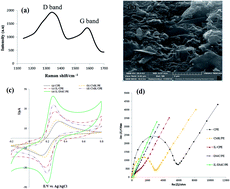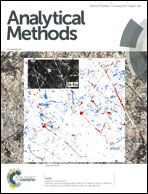A highly defective mesoporous carbon – ionic liquid paste electrode toward the sensitive electrochemical determination of rutin
Abstract
In this paper, a highly defective mesoporous carbon (DMC) and room temperature ionic liquid 1-butyl-3-methylimidazolium hexafluorophosphate (BMIM·PF6) were applied to fabricate a novel carbon paste electrode for the electrochemical sensing of rutin. The electrochemical properties of rutin on the modified electrode (IL/DMC/PE) were carefully investigated by cyclic voltammetry, electrochemical impedance spectroscopy and chronocoulometry. Electrochemical parameters of rutin on the surface of the modified electrode were determined with the electron transfer coefficient (α) as 0.53, the electron transfer number (n) as 2, the heterogeneous electron transfer rate constant (ks) as 37.1 s−1, the diffusion coefficient as 1.34 × 10−4 cm2 s−1 and saturated absorption capacity as 10.9 nmol cm−2. Under the optimal conditions, rutin could be detected in the concentration range from 0.008 μmol L−1 to 4.0 μmol L−1 with the detection limit as 1.17 nmol L−1 (S/N = 3) by square-wave voltammetry. The proposed sensor was further applied successfully for the determination of rutin content in some real samples, including Ruta graveolens extract, pharmaceutical tablets and orange juice.


 Please wait while we load your content...
Please wait while we load your content...